Is It Safe to Eat Strawberry Leaves
Yes, it's safe to eat strawberry leaves when properly cleaned and prepared. They're rich in vitamins A, C, and K, as well as minerals like calcium and iron. Strawberry leaves contain six times more antioxidants than the fruit itself and are an excellent source of dietary fiber. Before consuming, thoroughly wash the leaves to remove dirt and pesticides, and inspect for any signs of spoilage. You can enjoy them raw in salads, steep them for tea, or blend them into smoothies for a nutritional boost. While generally safe, be aware of potential allergies and consult a healthcare professional if you experience any adverse reactions. Exploring the various culinary uses and health benefits of strawberry leaves can enhance your overall well-being.
This post may contain affiliate links. If you make a purchase through these links, I may earn a commission at no additional cost to you. Additionally, portions of this post may be generated using artificial intelligence (AI) technology. While we strive for accuracy, please be aware that AI-generated content may not always be perfect and should be fact-checked when necessary.
The Spatula Scoops
- Strawberry leaves are safe to eat when properly washed and inspected for signs of spoilage or damage.
- They are rich in essential vitamins (A, C, K) and minerals (calcium, iron, magnesium), offering nutritional benefits.
- Strawberry leaves contain higher antioxidant content than the fruit itself, supporting overall health.
- Potential allergic reactions are possible, so first-time consumers should exercise caution and consult healthcare professionals if needed.
- The leaves can be consumed raw, cooked, or steeped as tea, offering versatility in culinary applications.
Nutritional Value of Strawberry Leaves
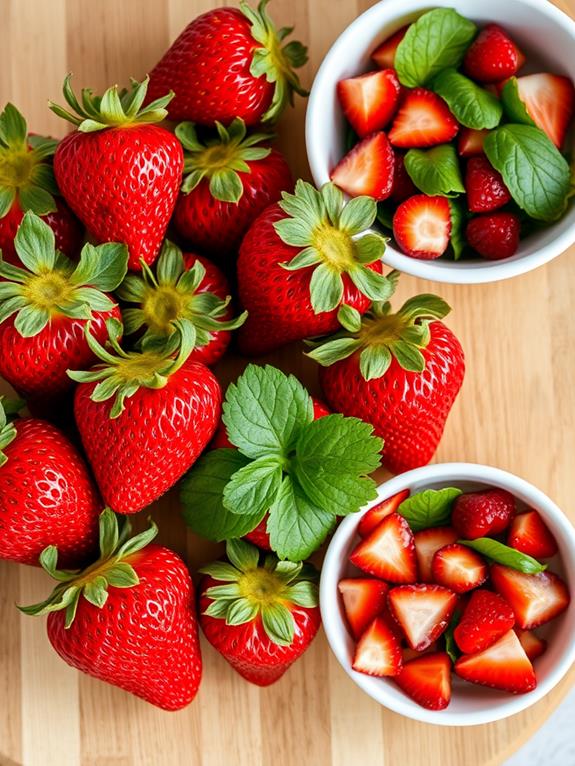
Exploring the nutritional value of strawberry leaves reveals a surprising powerhouse of health benefits. You might be wondering if it's safe to eat strawberry leaves, and the answer is a resounding yes. These often-overlooked parts of the strawberry plant are not only edible but also packed with nutrients that can boost your overall health. Additionally, cooking methods like those used for a cast iron skillet can enhance the flavors of various dishes, making it a versatile option for incorporating strawberry leaves into meals.
Strawberry leaves are rich in essential vitamins and minerals, including vitamins A, C, and K, as well as calcium, iron, and magnesium. What's even more impressive is their antioxidant content, which is about six times higher than that found in the fruit itself. These antioxidants, particularly polyphenols, play a vital role in reducing cancer risk and promoting cardiovascular health.
If you're looking to increase your fiber intake, strawberry leaves can help. They're an excellent source of dietary fiber, which is essential for digestive health. Considering that 95% of Americans don't meet recommended fiber intake, adding strawberry leaves to your diet could be a smart move. Plus, their low calorie count makes them a great option for weight management while still providing valuable nutrients.
Safety Considerations
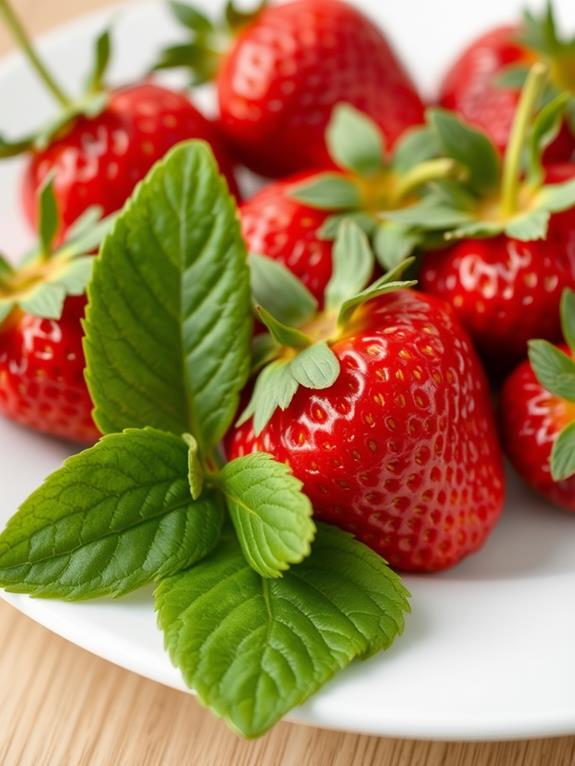
While strawberry leaves are safe to eat, there are several factors to keep in mind. First and foremost, it's vital to wash the leaves thoroughly before you consume them. This step helps remove any dirt, pesticides, or contaminants that might be present on the surface. As with any new food, if you have allergies, you should exercise caution when trying strawberry leaves for the first time. Some individuals may experience allergic reactions, such as redness or itching. Just like with other foods, verify you inspect the leaves for spoilage signs, as consuming spoiled foliage can lead to adverse health effects that mirror food poisoning risks like nausea or diarrhea, similar to those associated with expired tofu.
To make certain you're consuming only fresh leaves, discard any that appear brown or wilted. This practice helps maintain the quality and safety of your leafy snack. While strawberry leaves are generally safe to eat, it's important to pay attention to your body's response after consumption. If you experience any adverse symptoms, such as persistent nausea or shortness of breath, don't hesitate to consult a healthcare professional for guidance. By following these safety considerations, you can enjoy strawberry leaves as a nutritious addition to your diet without compromising your well-being. Remember, being informed and cautious allows you to explore new foods safely and confidently.
Preparing Strawberry Leaves

When preparing strawberry leaves for consumption, you'll need to start by thoroughly washing them under cool running water. It is essential to recognize that unlike bay leaves, strawberry leaves are non-toxic and can be safely consumed. You should then carefully inspect the leaves, removing any that are brown, wilted, or damaged. After cleaning and sorting, you can chop the leaves for use in various recipes, but remember to blanch them briefly if you want to improve their texture and flavor. The versatility of strawberry leaves can enhance your dishes, similar to how bay leaves contribute to flavoring the primary concern is choking hazards.
Washing and Cleaning Leaves
Proper cleaning of strawberry leaves is vital before consumption. You'll want to start by washing the strawberry tops thoroughly under cool running water. This step is essential for removing dirt and pesticide residues, as strawberries are part of the Dirty Dozen list, known for higher pesticide contamination. While cleaning, make sure to discard any brown or wilted leaves to guarantee freshness and safety.
After washing, pat the leaves dry with paper towels to prevent moisture buildup, which can lead to spoilage. It is significant to point out that you shouldn't wash the berries prematurely. Instead, clean the leaves just before use to maintain ideal freshness. If you need to prepare the leaves in advance, consider using a vinegar wash. This method can extend their freshness while still keeping them safe to eat.
Removing Damaged Portions
After cleaning your strawberry leaves, the next step is to carefully inspect and remove any damaged portions. As you examine the leaves, look for any signs of spoilage, such as brown or wilted areas. These damaged parts should be discarded immediately, as they're not suitable to eat and could affect the overall quality of your strawberry leaves.
When you're preparing to eat strawberry leaves, it's vital to guarantee that only the freshest, healthiest parts make it to your plate. After you wash the leaves thoroughly under cool running water, take a moment to scrutinize each one. Use your fingers or a small knife to remove any discolored or limp sections. This step is essential for both food safety and taste.
Chopping for Recipes
Most recipes that incorporate strawberry leaves call for them to be finely chopped. Before you start chopping, it's essential to properly clean the leaves. Wash them thoroughly under cool running water to remove any dirt or pesticides, guaranteeing they're safe to consume. After washing, pat the leaves dry with paper towels to maintain their freshness and prevent spoilage.
As you prepare the leaves for your recipes, discard any brown or wilted portions. This step guarantees you're only using the highest quality parts of the plant. Once you've sorted through the leaves, it's time to chop them into smaller pieces. This process enhances their flavor distribution in dishes and makes them easier to incorporate into various recipes.
For some dishes, you might want to take into account briefly blanching the chopped leaves. This technique can make them more tender and palatable, especially when you're adding them to salads or cooked dishes. By following these steps, you'll have perfectly prepared strawberry leaves ready to elevate your culinary creations with their unique flavor and nutritional benefits.
Culinary Uses
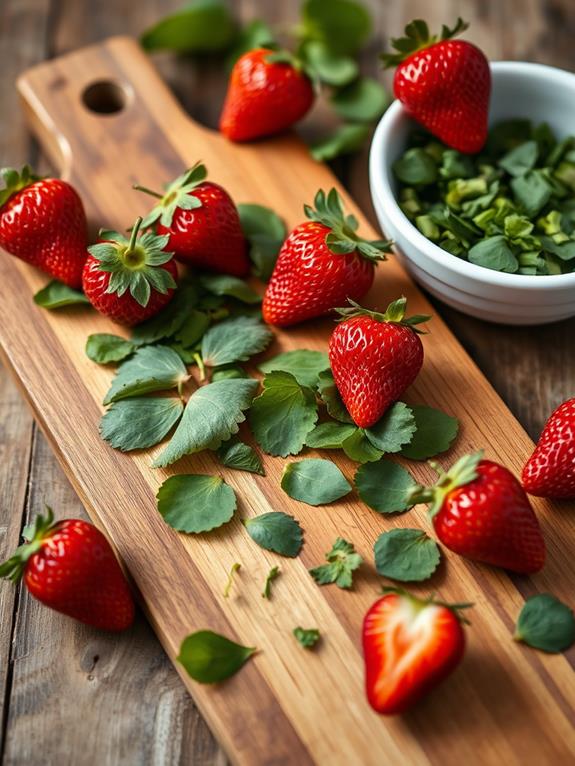
You'll find strawberry leaves can be surprisingly versatile in your kitchen. Fresh leaves can make a great addition to salads, offering an earthy flavor and nutritional boost. For those looking to bring a touch of health-conscious creativity to their meals, incorporating ingredients that are both simple and nourishing can enhance your cooking experience, similar to recipes in Skinnytaste's collection. For a soothing drink, you can steep the leaves in hot water to create a flavorful and digestive-friendly herbal tea, while adding them to your smoothies will amp up the antioxidant content and introduce vitamins A, C, and K.
Fresh Salad Additions
From atop your salad bowl, fresh strawberry leaves can add a delightful twist to your greens. These edible additions aren't just for show; they bring both nutritional value and biological benefits to your meal. Strawberry leaves can help boost your salad's vitamin C content and provide a subtle, earthy flavor that complements other ingredients.
When incorporating strawberry leaves into your fresh salad additions, consider pairing them with complementary flavors and textures. Here's a table showcasing some popular combinations:
| Strawberry Leaves | Complementary Ingredients | Dressing Suggestions |
|---|---|---|
| Young leaves | Goat cheese, walnuts | Balsamic vinaigrette |
| Mature leaves | Grilled chicken, almonds | Lemon-herb dressing |
| Chopped leaves | Feta, red onions | Raspberry vinaigrette |
| Whole leaves | Sliced strawberries, pecans | Poppy seed dressing |
| Wilted leaves | Bacon bits, hard-boiled eggs | Warm bacon dressing |
Flavorful Tea Infusions
Beyond their role in salads, strawberry leaves offer a world of culinary possibilities, particularly in the domain of flavorful tea infusions. You can steep these leaves in hot water to create a delightful herbal tea that's rich in antioxidants and offers an earthy taste. This tea isn't just tasty; it's also a great way to incorporate the high polyphenol content of strawberry leaves into your diet, potentially aiding in cancer risk reduction.
When preparing your strawberry leaf tea, remember these key points:
- Use fresh or dried leaves, ensuring they're thoroughly washed
- Enhance the flavor with complementary ingredients like lemon or mint
- Experiment with different steeping times to achieve your preferred strength
- Consider using the infusion as a base for cocktails or syrups
You're not limited to just drinking the tea, either. The infusion can be a versatile ingredient in your kitchen, adding a unique taste to various recipes while maximizing the nutritional benefits of the strawberry plant. By exploring these culinary applications, you're not only expanding your palate but also potentially boosting your health through the consumption of these nutrient-rich leaves.
Smoothie Nutrient Boost
Strawberry leaves can transform your smoothies into nutrient powerhouses. When you add these often-overlooked greens to your blender, you're greatly boosting the nutrient content of your drink. Strawberry leaves are packed with vitamins A, C, and K, as well as essential minerals like calcium and iron. They're also rich in antioxidants, containing about six times more than the strawberries themselves, which can help reduce oxidative stress in your body.
By incorporating strawberry leaves into your smoothies, you're not only enhancing the nutritional profile but also increasing your dietary fiber intake. This can help reduce the risk of fiber deficiency, a common issue for many Americans. The leaves add an earthy flavor that complements the sweetness of strawberries, creating a unique taste experience. Plus, using the entire strawberry, leaves and all, is a sustainable practice that reduces food waste.
When you blend strawberry leaves into your smoothies, you're making a smart choice for your health and the environment. It's an easy way to maximize the benefits of this fruit while exploring new flavors and textures in your daily nutrition routine.
Health Benefits
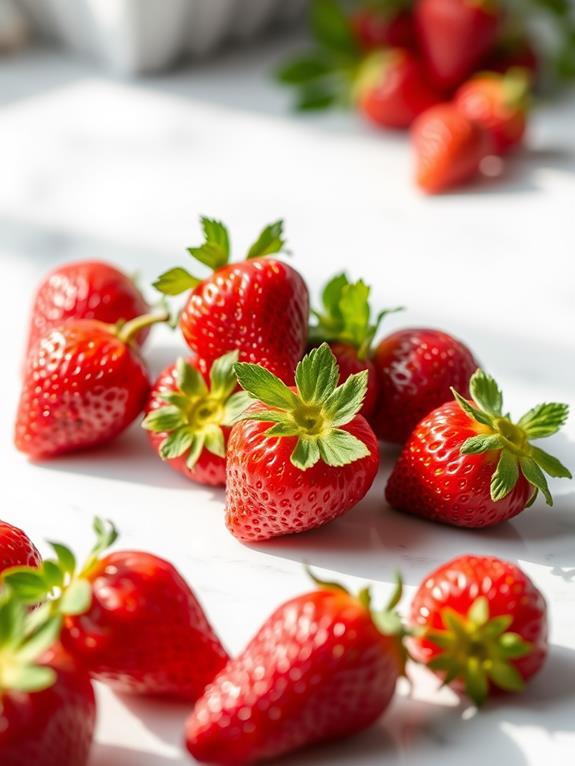
A treasure trove of nutrients, strawberry leaves offer numerous health benefits beyond their more popular fruit counterparts. These often-overlooked greens are packed with antioxidants, boasting an antioxidant capacity six times higher than the fruit itself. This makes them a nutritionally valuable raw material for supporting your overall health. Similar to the nutrient profile found in products like a delicious parmesan cheese substitute, the leaves can be a flavorful addition to your diet.
When you incorporate strawberry leaves into your diet, you'll be tapping into a range of potential health benefits:
- Immune system boost from high vitamin C content
- Improved bone health due to calcium-rich composition
- Enhanced red blood cell production thanks to iron content
- Better digestion and potential stomach discomfort relief
The leaves' anti-inflammatory properties may help reduce inflammation throughout your body, while their tannins can aid in digestive processes. You'll also be supporting your body's natural defenses against oxidative stress, which can contribute to various chronic diseases. It's essential to recognize that while strawberry leaves are generally safe for consumption, you should wash them thoroughly to remove any pesticides. If you have allergies, introduce them cautiously to your diet. By adding these nutrient-dense leaves to your meals or teas, you're embracing a simple yet effective way to enhance your nutritional intake.
Sustainability and Waste Reduction
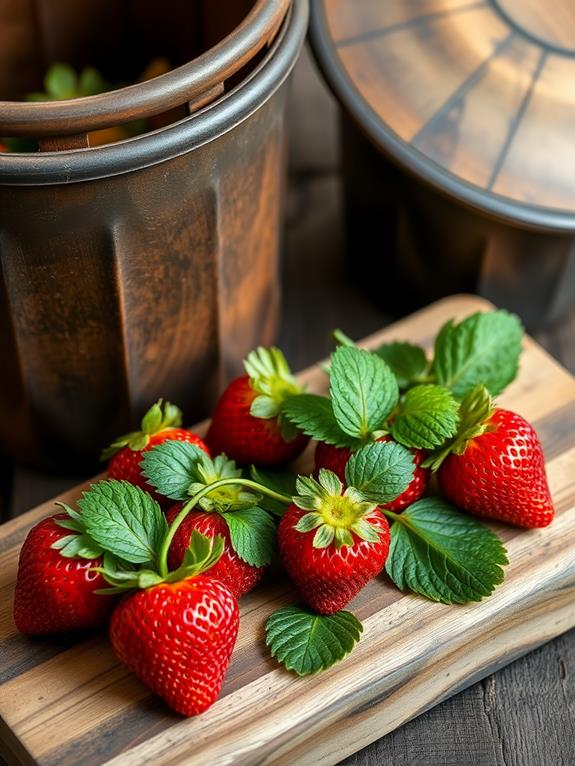
While strawberry leaves offer numerous health benefits, their consumption also plays a significant role in sustainability and waste reduction. When you eat strawberry leaves, you're contributing to responsible consumption practices by utilizing the entire fruit. This approach helps minimize food waste, as many people typically discard these edible scraps during preparation. Additionally, just like how stackable Pyrex mixing bowls optimize kitchen organization, incorporating strawberry leaves can enhance kitchen efficiency by ensuring that less is wasted.
By incorporating strawberry leaves into your meals, you're promoting sustainability in agricultural practices. You're encouraging the use of all edible plant parts, which supports a more environmentally conscious approach to food consumption. Instead of tossing the leaves into your compost bin, you're maximizing food usage and reducing overall waste.
Your decision to consume strawberry leaves increases awareness about the potential nutritional and culinary benefits of parts that are usually discarded. This mindset shift can lead to broader changes in how we view and use food. By embracing this practice, you're fostering local biodiversity and supporting sustainable agriculture. You're also setting an example for others to reconsider what they typically throw away, potentially inspiring a more waste-conscious approach to food consumption in your community.
Frequently Asked Questions
Can You Eat the Leaves of Strawberries?
Yes, you can eat strawberry leaves. They're safe and edible, offering health benefits due to their high antioxidant content. Before eating, make sure to wash them thoroughly to remove any dirt or pesticide residues. Discard brown or wilted leaves for freshness and safety. While generally safe, be cautious if you're trying them for the first time, as some people may experience allergic reactions. If you notice any adverse symptoms after consumption, it's best to consult with your doctor.
Are Strawberry Leaves a Laxative?
Did you know that strawberry leaves contain up to 8% tannins? While these compounds can have mild astringent effects, strawberry leaves aren't typically considered a laxative. They're high in fiber, which may promote regular bowel movements, but their effects are gentler than traditional laxatives. You might find that drinking strawberry leaf tea supports your digestion without intense effects. Remember, individual reactions can vary, so if you're considering using strawberry leaves for digestive health, it's best to consult with a healthcare professional first.
Are Strawberry Tree Leaves Edible?
Yes, strawberry tree leaves are indeed edible. You can safely consume them as part of your diet. These leaves, from the Arbutus unedo L. plant, offer various health benefits, including antiviral and antibacterial properties. They're rich in bioactive compounds, vitamins, minerals, and antioxidants. You can use them in teas, salads, or as a seasoning. However, it's essential to wash them thoroughly before consumption. While generally safe, be cautious and consult a healthcare provider if you experience any allergic reactions.
Why Remove Strawberry Leaves?
You might remove strawberry leaves for several reasons. First, they can be bitter or tough, affecting the overall taste experience. Second, if the leaves are brown or wilted, they're best discarded for freshness. Third, some people find the texture unappealing. Additionally, while leaves are generally safe, removing them eliminates any pesticide residues that might remain after washing. Finally, it's a personal preference; some enjoy the earthy flavor, while others prefer just the sweet fruit.





